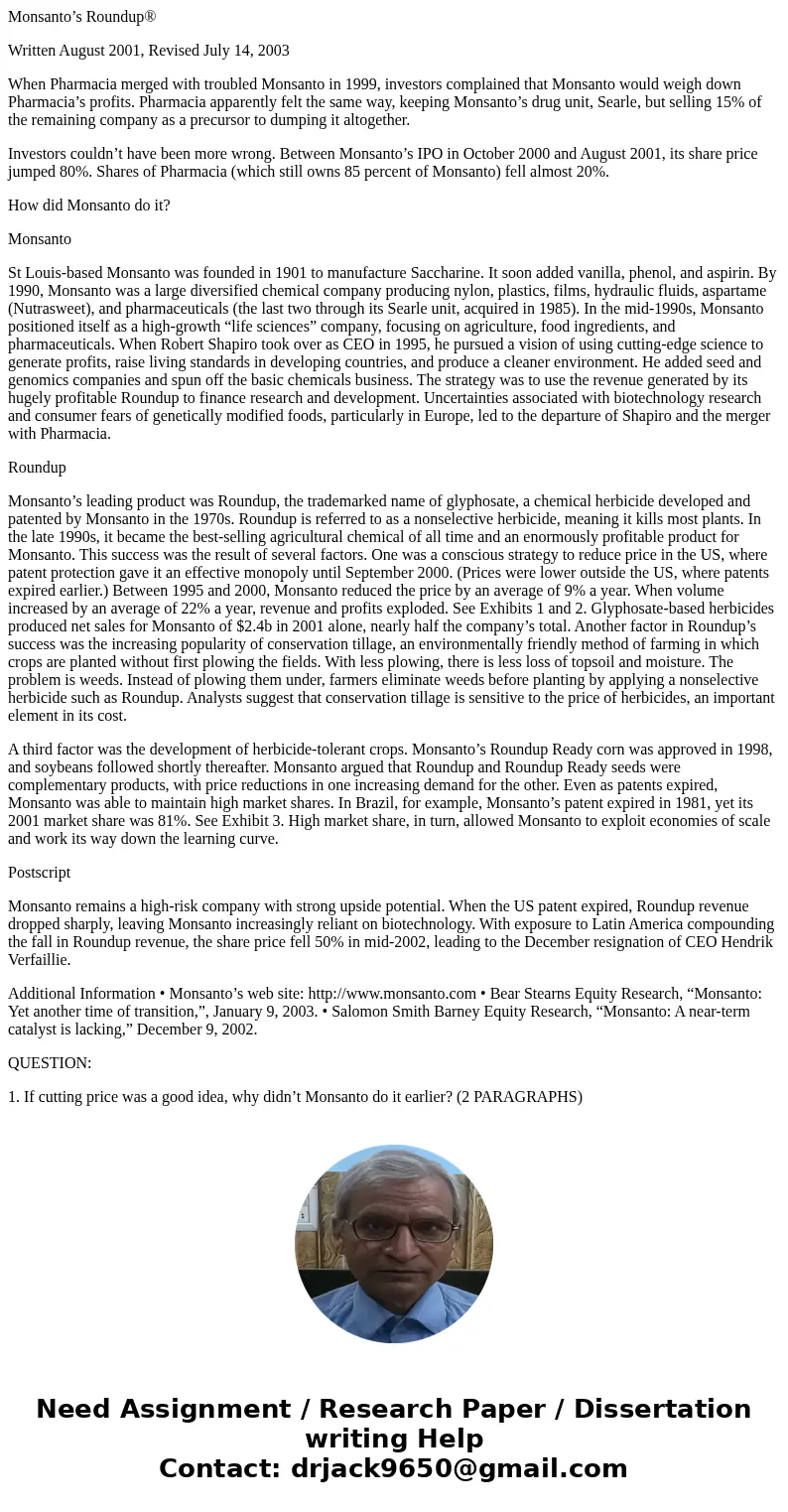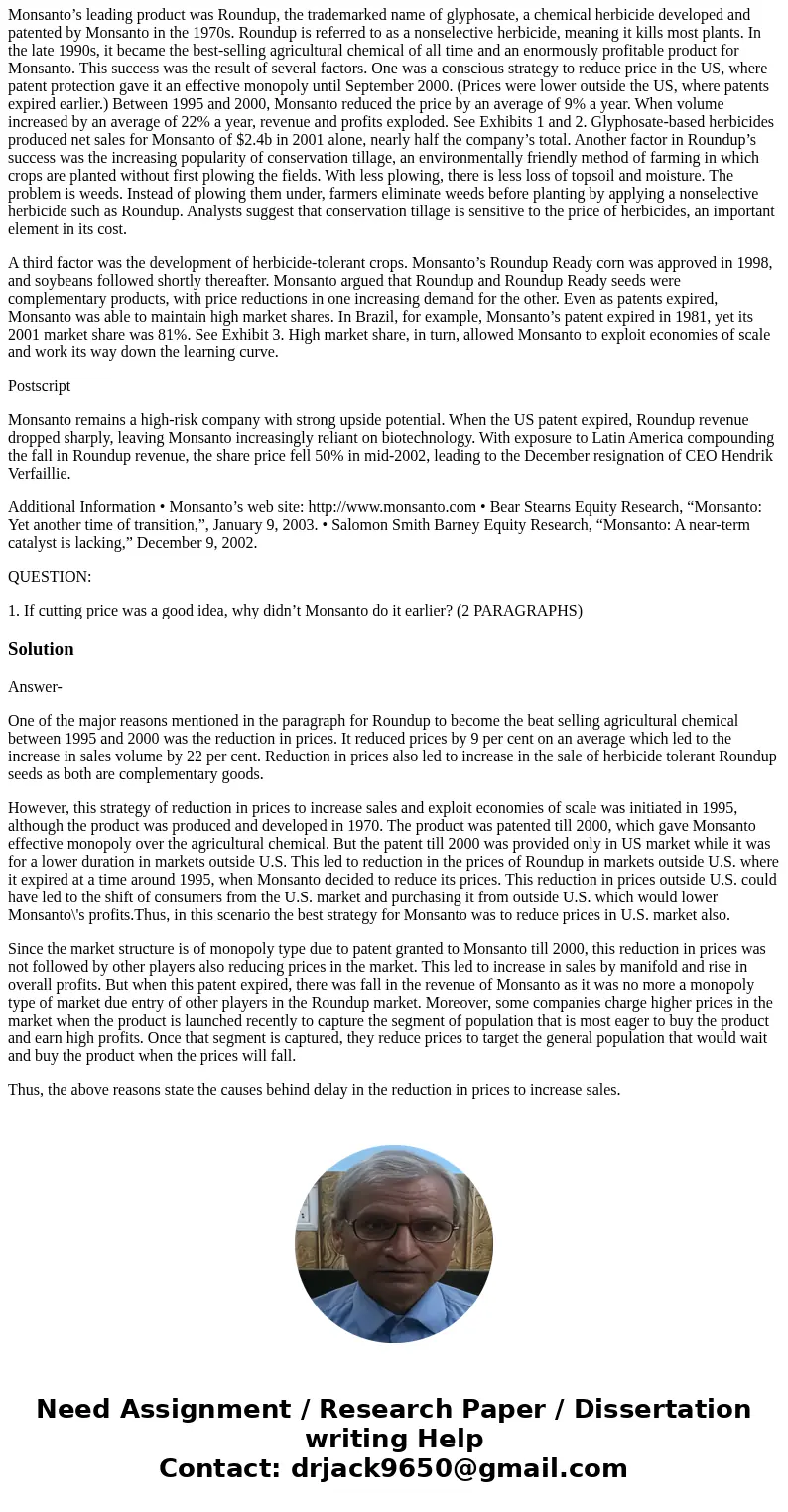Monsantos Roundup Written August 2001 Revised July 14 2003 W
Monsanto’s Roundup®
Written August 2001, Revised July 14, 2003
When Pharmacia merged with troubled Monsanto in 1999, investors complained that Monsanto would weigh down Pharmacia’s profits. Pharmacia apparently felt the same way, keeping Monsanto’s drug unit, Searle, but selling 15% of the remaining company as a precursor to dumping it altogether.
Investors couldn’t have been more wrong. Between Monsanto’s IPO in October 2000 and August 2001, its share price jumped 80%. Shares of Pharmacia (which still owns 85 percent of Monsanto) fell almost 20%.
How did Monsanto do it?
Monsanto
St Louis-based Monsanto was founded in 1901 to manufacture Saccharine. It soon added vanilla, phenol, and aspirin. By 1990, Monsanto was a large diversified chemical company producing nylon, plastics, films, hydraulic fluids, aspartame (Nutrasweet), and pharmaceuticals (the last two through its Searle unit, acquired in 1985). In the mid-1990s, Monsanto positioned itself as a high-growth “life sciences” company, focusing on agriculture, food ingredients, and pharmaceuticals. When Robert Shapiro took over as CEO in 1995, he pursued a vision of using cutting-edge science to generate profits, raise living standards in developing countries, and produce a cleaner environment. He added seed and genomics companies and spun off the basic chemicals business. The strategy was to use the revenue generated by its hugely profitable Roundup to finance research and development. Uncertainties associated with biotechnology research and consumer fears of genetically modified foods, particularly in Europe, led to the departure of Shapiro and the merger with Pharmacia.
Roundup
Monsanto’s leading product was Roundup, the trademarked name of glyphosate, a chemical herbicide developed and patented by Monsanto in the 1970s. Roundup is referred to as a nonselective herbicide, meaning it kills most plants. In the late 1990s, it became the best-selling agricultural chemical of all time and an enormously profitable product for Monsanto. This success was the result of several factors. One was a conscious strategy to reduce price in the US, where patent protection gave it an effective monopoly until September 2000. (Prices were lower outside the US, where patents expired earlier.) Between 1995 and 2000, Monsanto reduced the price by an average of 9% a year. When volume increased by an average of 22% a year, revenue and profits exploded. See Exhibits 1 and 2. Glyphosate-based herbicides produced net sales for Monsanto of $2.4b in 2001 alone, nearly half the company’s total. Another factor in Roundup’s success was the increasing popularity of conservation tillage, an environmentally friendly method of farming in which crops are planted without first plowing the fields. With less plowing, there is less loss of topsoil and moisture. The problem is weeds. Instead of plowing them under, farmers eliminate weeds before planting by applying a nonselective herbicide such as Roundup. Analysts suggest that conservation tillage is sensitive to the price of herbicides, an important element in its cost.
A third factor was the development of herbicide-tolerant crops. Monsanto’s Roundup Ready corn was approved in 1998, and soybeans followed shortly thereafter. Monsanto argued that Roundup and Roundup Ready seeds were complementary products, with price reductions in one increasing demand for the other. Even as patents expired, Monsanto was able to maintain high market shares. In Brazil, for example, Monsanto’s patent expired in 1981, yet its 2001 market share was 81%. See Exhibit 3. High market share, in turn, allowed Monsanto to exploit economies of scale and work its way down the learning curve.
Postscript
Monsanto remains a high-risk company with strong upside potential. When the US patent expired, Roundup revenue dropped sharply, leaving Monsanto increasingly reliant on biotechnology. With exposure to Latin America compounding the fall in Roundup revenue, the share price fell 50% in mid-2002, leading to the December resignation of CEO Hendrik Verfaillie.
Additional Information • Monsanto’s web site: http://www.monsanto.com • Bear Stearns Equity Research, “Monsanto: Yet another time of transition,”, January 9, 2003. • Salomon Smith Barney Equity Research, “Monsanto: A near-term catalyst is lacking,” December 9, 2002.
QUESTION:
1. If cutting price was a good idea, why didn’t Monsanto do it earlier? (2 PARAGRAPHS)
Solution
Answer-
One of the major reasons mentioned in the paragraph for Roundup to become the beat selling agricultural chemical between 1995 and 2000 was the reduction in prices. It reduced prices by 9 per cent on an average which led to the increase in sales volume by 22 per cent. Reduction in prices also led to increase in the sale of herbicide tolerant Roundup seeds as both are complementary goods.
However, this strategy of reduction in prices to increase sales and exploit economies of scale was initiated in 1995, although the product was produced and developed in 1970. The product was patented till 2000, which gave Monsanto effective monopoly over the agricultural chemical. But the patent till 2000 was provided only in US market while it was for a lower duration in markets outside U.S. This led to reduction in the prices of Roundup in markets outside U.S. where it expired at a time around 1995, when Monsanto decided to reduce its prices. This reduction in prices outside U.S. could have led to the shift of consumers from the U.S. market and purchasing it from outside U.S. which would lower Monsanto\'s profits.Thus, in this scenario the best strategy for Monsanto was to reduce prices in U.S. market also.
Since the market structure is of monopoly type due to patent granted to Monsanto till 2000, this reduction in prices was not followed by other players also reducing prices in the market. This led to increase in sales by manifold and rise in overall profits. But when this patent expired, there was fall in the revenue of Monsanto as it was no more a monopoly type of market due entry of other players in the Roundup market. Moreover, some companies charge higher prices in the market when the product is launched recently to capture the segment of population that is most eager to buy the product and earn high profits. Once that segment is captured, they reduce prices to target the general population that would wait and buy the product when the prices will fall.
Thus, the above reasons state the causes behind delay in the reduction in prices to increase sales.


 Homework Sourse
Homework Sourse